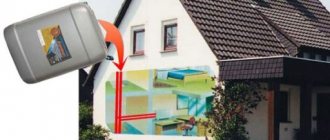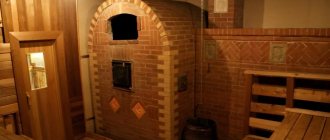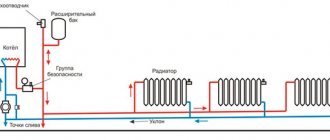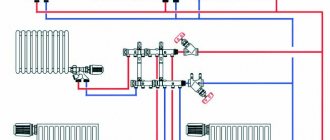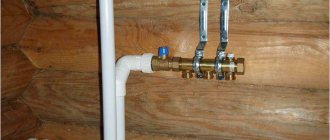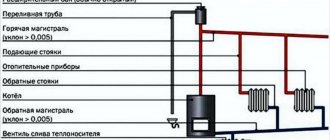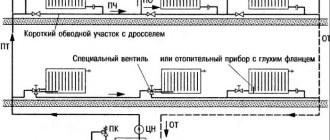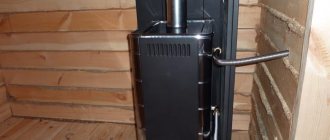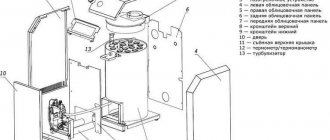Definition and types
General
We will speak in as simple a language as possible, since the article was written not for specialists, but for ordinary consumers of heating services. So, horizontal heating distribution assumes the presence of 2 main risers, which are located in the entrance or technical room.
One riser is the supply of hot coolant, the second is the outlet of cooled coolant. Further on each floor there is a collector, from which 2 taps are connected to each apartment.
From these taps, two pipes are laid along the floor (supply and return), which supply heat to the radiators. Moreover, all the pipes are hidden in the floor screed, which is undoubtedly much more aesthetically pleasing than the ubiquitous Soviet-style heating risers.
Of course, such a system has its advantages and disadvantages, some differences in pipe distribution and water supply patterns, and we will certainly consider them.
Single-pipe
As can be seen in the photo, water supply and drainage are carried out through one pipe. This provides some savings in materials, but also has obvious disadvantages:
- The coolant cools as it moves along the circuit;
- It is difficult to achieve the same temperature of the first and last radiators in the circuit;
- The system is less dynamic and adjustable.
Attention! Today, such systems are used only in private construction, when the heating circuits are small and the temperature difference is insignificant. In apartment buildings, two-pipe systems are used.
Two-pipe
It has a number of advantageous differences:
- it is supplied by one pipe, and discharged back by another;
- During the circulation process, the water does not cool down from one radiator to another, and the temperature on each radiator is approximately the same, which allows you to create a more comfortable microclimate in the apartment and distribute the coolant evenly;
- It becomes possible to adjust the temperature depending on weather conditions;
- Thanks to the adjustment, heating savings reduce costs by 1.5 - 2 times.
Double-tube beam
The most progressive and modern scheme. The radial system is also called a collector system, since a distribution manifold is installed in the apartment, from which forward and return pipes are connected to each individual radiator.
Differences:
- The number of pipes increases, but the excess consumption of material is compensated by the convenience and excellent flexibility of the system;
- It is possible to adjust the temperature load of each individual radiator, which makes it possible to fine-tune the microclimate of the room;
- Requires circulation pumps;
- Each heating circuit is an independent system; it is possible to equip it with its own taps, pumps and automation;
- In the event of a radiator replacement or an accident, you don’t have to turn off not only the entire riser, but even the entire apartment: just shut off the water supply to a specific radiator;
- Horizontal heating radiators in collector systems do not require air vents; these elements are installed on the collector.
Horizontal and vertical heating distribution in an apartment building 2021
The level of heat supply directly depends on the type of wiring of the heating system in an apartment or house. The most common schemes are single-pipe and two-pipe horizontal heating systems.
Heating system design
In any apartment, all elements of the heating system are connected according to one scheme or another. The pipeline can be routed vertically or horizontally.
In the first case, the main sun lounger is located in the basement. Riser pipes of smaller diameter extend from it, to which pipes and radiators in the apartment are connected. The main advantage of vertical wiring is its low cost and simplicity.
A single-pipe vertical system can have top or bottom wiring. Both types have their own technical characteristics. When installing a single-pipe vertical system with overhead pipe distribution, the supply pipeline is laid in the attic or on the technical floor. From the sun lounger, the coolant is supplied to the apartments through series-connected risers.
Such a system is static. It will not be possible to scale it by changing the number of radiators and installing regulators. It can save pipes during installation, but requires the installation of a large number of heating devices. Single-pipe vertical systems are well suited for projects that involve natural circulation of coolant.
A two-pipe system with bottom wiring has a supply pipeline and a return line. They are laid on the floor surface or in the floor, for example, in a screed. When implementing such a system, the coolant enters each battery independently. This scheme is not without nuances. Each radiator must have a tap through which air can be vented.
Unlike single-pipe systems, two-pipe systems are adjustable circuits. Communications built in this way make it possible to turn off any heating device in the network. Overconsumption of radiators is also not typical for them, but the total length of the pipeline will be significantly greater compared to a single-pipe scheme. In apartment buildings, the two-pipe system has one more nuance. It is almost impossible to install an individual heat meter here. And the use of communal heat meters is beneficial mainly for residents of the first floors.
The basis of the horizontal distribution is the supply riser, passing through all floors. Sun loungers are connected to the riser, supplying heat to individual apartments. The use of horizontal wiring requires careful insulation of the riser, since significant heat loss occurs here. To reduce heat loss as much as possible, risers are often installed in specially equipped shafts.
Single-pipe circuits have a narrow scope of application - heating large areas. Therefore, they are almost never installed in residential buildings. Horizontal two-pipe system
well suited for providing heat to apartment buildings.
Installation of a two-pipe heating system in general terms is as follows:
- From the main supply riser, a supply and return pipe are laid on each floor, and radiators are also connected.
- Shut-off valves are installed on all radiators, without exception.
An important advantage of the scheme is the ability to connect/disconnect heat on a floor-by-floor basis. Sunbeds can be laid in the floor screed. This scheme allows the use of radiators with bottom connections. All this has a good effect not only on heat supply, but also on the aesthetic appeal of apartments. It is impossible not to note another important fact - the possibility of installing individual heat meters.
For all its undeniable advantages, the system is not ideal. The difficulty lies in the need to install compensators for a significant length of the main line. The operation of the system as a whole is also becoming more complicated, since the installation of shut-off valves and air valves is required on each radiator, without exception.
Heating wiring diagram in a private house
We should also talk about another popular wiring scheme - this is a two-pipe manifold floor-to-floor system. Its peculiarity lies in the installation of supply and return manifolds on each floor. As in the case of the already described option, the heart of the system is the common supply riser. If there are a large number of consumers in the house, it is possible to install several risers. Two collectors are installed on each floor - supply and return, and from them there are pipelines supplying coolant to the radiators.
Unlike traditional options, the collector floor scheme has a significant pipeline length. Considering that metal-plastic pipes are used for installation of the circuit, the implementation of such a project turns out to be more expensive than conventional options.
Important! Despite this drawback, collector circuits, from the point of view of operational features, are much more efficient and simpler than other options. This makes them increasingly popular not only in multi-storey buildings, but also in individual construction.
The two-pipe collector system guarantees an even supply of heat to all rooms. For comparison, it is worth remembering the operating principle of single-pipe circuits. In them, heat is supplied and removed through one pipe, and radiators are connected in parallel. As it moves through the pipeline, the coolant cools down. As a result, the further the radiators are located from the supply pipe, the colder the water in them, and, as a result, the lower the air temperature in the room. It is impossible to install regulators in such connection diagrams. Therefore, even within the same apartment it is impossible to achieve uniform heat.
Two-pipe circuits make it possible to reduce this disadvantage to a minimum. The cooled coolant is removed from the system via the return line. The water does not cool down as it moves from radiator to radiator, which means that all rooms will have approximately the same temperature. Such thermal indicators provide the most comfortable microclimate in the apartment. We must not forget that in such systems it is possible to install temperature regulators. And this gives not only comfort, but also savings and efficient use of funds. In general, the installation of an expensive collector circuit pays for itself within 2–3 heating seasons.
Installation of heating systems
Important differences between two-pipe beam (collector) systems are:
- Flexibility and scalability of the scheme.
- Possibility of installing thermostats on each radiator.
- The need to ensure forced circulation of the coolant using circulation pumps.
- Each circuit is a separate system with additional equipment and automation.
- There is no need to install air vents on radiators.
- High system reliability, reduction in the number of accidents and leaks.
- High resistance to water hammer.
- Aesthetics
This is interesting: Payments under the resettlement program for compatriots 2021
We can talk about the economic and operational advantages of horizontal two-pipe collector systems for a very long time, but we cannot fail to note another advantage of them - aesthetics. Modern man values comfort. Even inexpensive renovations are done, if not with the involvement of a designer, then at least using the latest design trends. The presence of risers throughout the apartment does not go well with modern design. In old houses, the issue of risers is aggravated by another significant problem - constant smudges and leaks that can kill even the best and most expensive repairs.
In two-pipe manifold circuits, all pipelines are laid in the floor screed. Not only do they not spoil the apartment, they are absolutely invisible. Laying pipes in a screed is possible thanks to the use of modern materials - plastic and metal-plastic. They are not subject to corrosion, are not afraid of low temperatures and even freezing of the coolant.
Horizontal radial patterns also make it possible to ensure truly high comfort in each room thanks to the possibility of installing heat regulators. The temperature of the house is regulated depending on the weather outside the window. The result is a highly energy efficient system.
Among all existing heating network installation schemes, the best option remains a horizontal radial two-pipe system. Despite the higher cost of installation, it is becoming increasingly popular not only in multi-storey buildings, but also in private housing construction. This popularity of collector circuits is explained by a unique combination of excellent technical, operational, economic and aesthetic indicators.
Houses can use horizontal and vertical wiring of the heating system. In modern multi-storey construction, horizontal wiring is increasingly used, which demonstrates good technical, aesthetic and operational characteristics. This article will discuss the horizontal layout of the heating system.
Horizontal heating distribution has a number of advantages:
- High degree of heat transfer control . In such a scheme, it is very easy to monitor heat consumption due to automatic remote control.
- Possibility of individual configuration of each section . On any section of the circuit, you can adjust the temperature separately, depending on the specific needs of the room.
- Possibility of hidden installation . The horizontal heating system is perfect for hidden installation, which allows you to visually unload the room and thereby improve its interior.
- Reliability . When using good components and proper installation, a horizontal system can operate for several decades without problems.
Among the shortcomings, the following points can be highlighted:
- Sometimes it becomes necessary to manually configure the system;
- In case of mechanical damage, serious problems arise with the system.
Horizontal and vertical heating systems have a lot of differences, so to choose a suitable design you need to study them in detail. Further we will talk only about the horizontal system.
There are several types of horizontal wiring:
- Single-pipe;
- Two-pipe;
- Two-pipe manifold.
Each scheme needs to be considered in more detail.
In such a system there are several heat sources through which heating pipes pass. The coolant moves through such a system and transfers heat to devices located in certain sections of the circuit. Single-pipe horizontal heating in an apartment building has good efficiency and is relatively inexpensive.
The advantages of such a system are as follows:
- Minimum cost;
- Easy installation;
- Wear resistance and long service life;
- The ability to fully warm up a building of any size.
- The ability to adjust the temperature on each individual device is limited;
- Weak resistance to mechanical damage.
A key feature of single-pipe wiring is the need to gradually increase the size of the radiators in the order of their distance from the heat generator - this rule allows you to balance the heat transfer. In the case of a long system, heating collectors will have to be installed more often so that the coolant does not have time to lose temperature.
This horizontal heating distribution in an apartment building, as the name implies, includes two main lines, along one of which the coolant moves forward, and along the second it returns to the heat generator. Heat transfer is carried out through radiators, which are installed under windows or near walls facing north, because the most noticeable cold flows come from them.
A two-pipe system must be equipped with shut-off valves. These elements allow, if necessary, to turn off individual parts of the system without stopping the entire heating circuit. In addition, compensators are needed that neutralize the negative effects of pressure. A properly assembled system can normally withstand maximum pressure and water hammer, and will not freeze even at subzero temperatures.
The advantages of such a system include:
- No temperature difference between inlet and outlet;
- Possibility of application in buildings of any configuration;
- Possibility of switching off a separate section of the circuit without completely stopping the system.
The main and most noticeable disadvantage is the difficulty of fine-tuning the temperature if the system has a large number of branches - vertical wiring of the heating system in this regard is somewhat simpler, but not as effective.
This horizontal wiring diagram has a closed structure, consisting of several branches, each of which is connected to its own devices. As a rule, polymer or polyethylene pipes are used for such wiring - their strength and performance characteristics are quite sufficient for the normal operation of the system, and they are cheap.
In such a system, the connection goes directly to the collector, which ensures uniform distribution of thermal energy throughout the entire heated area. With this scheme, the supply and return circuits operate independently of each other. The coolant passes through the radiators and is sent back for the subsequent heating cycle. The result is a closed system, the operation of which is regulated automatically.
Horizontal parallel wiring is quite suitable for arranging any projects, since the design includes several simple elements that are easy to customize. What is important is that when using this scheme, radiators do not need to be equipped with air bleed valves.
The system must have a good circulation pump - heating operation in the horizontal installation option under consideration is only possible if there is a pump. The distribution panel, in which all the equipment is located, is usually placed in corridors or bathrooms, and for multi-story buildings, the option of placing the panel in the basement is quite suitable.
This is interesting: How to get a free register of owners of MKD 2021
The list of advantages of such a layout is as follows:
- Low cost of arrangement;
- Possibility of hidden installation;
- Possibility of combining several individual elements into one system;
- Possibility of full heating of large areas;
- No water hammer.
There are also disadvantages, and the most prominent among them are:
- Difficulty of installation;
- The need to use pipes of the same diameter.
During installation, it is necessary to pay attention to the quality of thermal insulation of the heating system, especially the riser. It would not be superfluous to arrange an insulated box intended for installing a riser. In any case, it is better to entrust the design and installation of a two-pipe manifold circuit to specialists who have experience in carrying out such work.
Horizontal wiring of the heating system has a number of positive qualities and is well suited for a wide variety of conditions. Arranging such wiring in a complex configuration cannot be called simple, so it is worth hiring specialists for this work.
Heating wiring is a diagram of the location of heating devices and pipes connecting them. The efficiency of the heating system, its efficiency and aesthetics significantly depend on the type of wiring. Main types of heating wiring:
- Single-pipe and double-pipe
- Horizontal and vertical
- Dead-end and with counter-movement of coolant
- Heating with top and bottom wiring
A specific heating system must have one of two characteristics from all four groups of characteristics. For example, the wiring can be single-pipe horizontal with upper heating wiring and dead-end movement of the coolant, or it can be two-pipe horizontal with lower wiring and counter movement of the coolant, etc. Let's consider these schemes based on the possibility of installing a heat meter for apartment heat metering.
It became most widespread in the Soviet Union from 1960 to 1999 due to the low cost and ease of laying utilities. The engineers of that time did not think too much about the problems associated with its applications.
This wiring system is common mainly in houses built before the beginning of 2000. In such houses, the supply line runs along the technical floor or in the basement of the house, and the coolant enters each battery sequentially (gradually cooling) through vertical risers.
Advantages: low pipe consumption. Because of it, some unscrupulous developers continue to create houses with such wiring to this day. Disadvantages: the impossibility of turning off individual heating devices and the impossibility of adjusting them, excessive consumption of heating devices, and large heat losses of the coolant. Which implies the impossibility of installing residential heat meters .
If with a one-pipe distribution the coolant moves along one solid circuit through all the radiators, then with a two-pipe system there are two risers: from one the coolant enters the radiator, and into the other it leaves.
With a two-pipe heating system with bottom wiring, the supply and return main pipelines pass in the floor of the lower floor of the building or in the basement, and the coolant flows independently into each radiator.
Advantages: good regulation of the heating system, the ability to separately turn off each heating device, no overconsumption of heating devices.
Disadvantages: the length of pipelines increases compared to a single-pipe scheme, the practical impossibility of installing apartment heat meters.
- Metrological problem . The heat meter is considered to be working correctly when the difference in coolant temperatures between the inlet and outlet (supply and return) is more than 3 o C. The heat consumption of 1 radiator, depending on the size, fin coefficient and heating area, ranges from 0.5 o C to 2 o C.
- The need to install heat meters on each riser , which is expensive and very troublesome. In the future, the user will have to manually take readings from each of the meters, sum them up and submit them to the heat supply organization. Risk of mathematical error and human factor. High verification costs, which partially offsets the savings from installation and increases the payback.
- The scope of application of the device is written in the heat meter passport . For example, for Ultraheat T-230 - “The meter is used to account for energy consumption in apartments, cottages, apartment buildings and small businesses... the temperature in the supply and return pipelines is measured.... etc.". There is no word anywhere about the battery, and there is no supply or return pipeline on the battery.
All of the above reasons are arguments for heat supply organizations not to take into commercial accounting heat meters installed in houses with a vertical heating system.
The only way to organize heat metering with a vertical heating distribution scheme is through heat distributors.
In this case, the main pipeline goes through all floors; on each floor there are heating niches, in which, through branches from the risers, each of the rooms on the floor has its own connection (via horizontal pipes located in the floor) to the general heating system.
Horizontal single-pipe circuits are rarely used, they have a rather narrow scope of application and they are not used for heating apartment buildings, so here we will consider options for two-pipe wiring.
Looking at the figure, you can see that from the main supply and return risers along the perimeter of the room, pipelines are laid in the floor to each heating device. Each apartment has its own heating system input. A heating niche with main risers can be located both in the apartment itself and in the common corridors (on the floor of the apartment or 1 floor below the apartment), depending on the design of the in-house heating distribution.
Each radiator is equipped with Mayevsky valves for bleeding air, and often automatic air collectors are installed on each of the floor heating outlets.
This wiring scheme is the most common in multi-storey residential buildings due to its ease of execution and affordability for developers.
Advantages: similar to a two-pipe vertical system, plus there are no risers on each heating device (except for main risers). It is possible to switch off the heating system on a floor-by-floor basis and use radiators with bottom connections, which, along with laying main pipelines in the floor structure or in the baseboard, allows you to minimize the number of open pipes and improve the aesthetics of the interior of the premises.
This is interesting: Wheelchair ramp at the entrance 2021
In such heating systems, apartment heat meters can be used.
Disadvantages: the need to use pressure compensators in high-rise buildings, complicated operation due to the presence of air valves on each heating device, high heat loss in the floor and through the building envelope.
In the heating niches at the outlets from the main pipeline (riser) on each floor there are collectors - supply and return. From the collectors, supply and return pipelines under the floor are led individually to each radiator in the apartment.
Advantages: similar to two-pipe horizontal heating systems with higher reliability of the system as a whole, high level of energy efficiency and lower energy consumption for heating.
Disadvantages: long supply pipelines, high cost.
The radial wiring scheme is innovative for our country. Today, such a system is becoming increasingly popular in construction.
In such heating systems, apartment heat meters can be used.
When routing heating pipes, various schemes are used that determine the operating features of the system, material costs, and methods for connecting radiators. The heating distribution diagram in a modern apartment building is, as a rule, carried out using vertical technology, which most fully satisfies the requirements of non-standard layouts.
The vertical scheme differs from the horizontal analogue, first of all, in minor heat losses. This feature is due to the carefully thought-out arrangement of the main pipes, which function as risers.
Interestingly, this technique owes its appearance to new construction standards in the country. Initially, it was not widespread, which is due to certain installation nuances. Things changed dramatically when five-story Khrushchev-era buildings began to be actively built in the USSR, the area of apartments in which was small, and therefore there was no need for horizontal wiring. In order to save money, a vertical methodology was created, characterized by a number of nuances:
- There are several risers with circulating coolant running vertically, to which radiators are connected;
- Each of the radiators can be configured separately;
- The coolant enters the premises through a separate circuit.
If we talk about private cottages, then such a heating distribution can be used there, but the owners need to prepare for some difficulties. An example of such a problem is that most batteries on the modern market are designed for connection to horizontal systems; they have the appropriate arrangement of pipes, technological holes and sections. Thus, the circuit, ideally, needs special radiators designed specifically for vertical installation.
Another problem arises from this feature. As you know, it is better to install radiators closer to the floor, this will allow for effective air exchange without unnecessary effort. Cold air, according to the laws of physics, will fall down, and heated air will rise up. A vertical radiator is extremely difficult to install in this way, which is why the heating is insufficient.
- The number of floors is greater than or equal to five;
- Each individual room has a small area;
- Sufficient thermal insulation of walls.
If we talk about heat energy metering, it is recommended to install the meter directly on the riser.
Read in more detail: Diagram and installation of a two-pipe heating system.
The scheme may involve the presence of one or two pipes:
- The option with one pipe implies that the coolant circulates in a closed loop, and the radiators are connected in series. This design feature leads to the fact that the temperature of the last battery will be lower than that of the first devices. However, with a short contour, this shortcoming is naturally corrected. As an additional way of adjustment, you can use the taps between the radiator pipes. Minimum volumes of materials for forming the system, no need for a circulation pump, small volume of circulating coolant - these properties can be attributed to the advantages of the technology.
- The two-pipe scheme is based on the installation of two circuits. The first is used to supply coolant to the radiators, while the second sends cooled water to the boiler for new heating. When laying, you must remember that the pipes must run next to each other, because the radiators are connected in parallel. An additional pipe increases the total volume of coolant used; often it is impossible to supply it by gravity, and therefore it is necessary to install a circulation pump. However, despite some installation inconveniences, the system is more reliable than the first option, since the formation of an air lock is eliminated.
To complete the picture, it is worth considering the horizontal wiring method. Its advantages are as follows:
- In the event of an emergency, it is possible to disconnect only the damaged battery. The method is also convenient when changing heating devices in a separate apartment; there is no need to cover the entire riser.
- It is possible to install energy meters in each apartment, thanks to which residents will be able to adjust the operation of the batteries so that it is both economical and contributes to the formation of an optimal microclimate. For example, during a long business trip or vacation, the room temperature is artificially lowered.
- The technique is independent from the rest of the apartments in the house, and therefore the owner arranges the heating in full accordance with personal requirements. There are no risers in the apartment, and individual pipes can be laid in niches, which is valuable when creating designer interiors.
- It is believed that this technology is more durable.
- The pipes are not laid in the walls, but in special niches and corrugations. This approach is optimal from the point of view of maintainability; the lightweight structure can be easily disassembled to get to the emergency area.
Thus, a residential building can be supplied with heat using any of the described schemes. In order to make the best choice, it is necessary to take into account all the nuances, positive and negative aspects of decisions. Even the vertical option, which may seem inferior to its horizontal counterpart, in a multi-storey building guarantees effective heating with small financial investments during the installation stages.
»
Other
How to get a free register of owners of MKD 2021
Read more
Great article 0
Economic aspect
Reading about so many benefits, you involuntarily ask yourself a reasonable question: how much does it all cost, since free cheese is only available in one place? Of course, such systems are somewhat more expensive than traditional vertical distributions with natural circulation.
Specialists from leading construction companies in Russia answer this question in this way: the cost of installation and equipment of horizontal heating systems falls on the shoulders of the developer and amounts to about 20%.
But at the same time, thanks to subsequent heat savings due to adjustment, the consumer pays back the costs within two to three years. The number of accidents and leaks is also reduced, and dependence on the quality of housing and communal services is reduced.
The buyer receives an apartment with ready-made screed in all rooms, and this is high-quality, smooth work done to all standards.
Important! The price of polypropylene pipes is much lower than metal ones, and their service life can be more than 50 years. These pipes are not afraid of water hammer, are not subject to corrosion, and are capable of expanding (they do not burst even when the water in them freezes).
It is also worth noting this nuance: transportation costs are significantly reduced and installation is simplified due to the low weight of polypropylene compared to steel.
Aesthetics and comfort
The aesthetic side of the issue also plays an important role. Increasingly, consumers are placing increased demands on the interior of their home. Designer renovations have come into fashion, implying that the interior matches a certain style.
At the same time, not every style is able to accommodate “scoop” risers in every room, and leaking pipes can turn expensive repairs into a pitiful sight quickly enough.
The horizontal arrangement of the distribution pipes allows you to hide them in the floor screed, which significantly increases the visual appeal of the room and the possibilities of interior decoration.
In addition, modern people no longer want to put up with conditions and adapt to the climate. When investing in real estate, the buyer wants to get housing that is comfortable in all respects.
In winter, the temperature regime is especially changeable: after severe frosts, sharp warming may occur, and the temperature increases several times. Naturally, if the radiators heat up as before, the apartment will become hot.
You will have to open the windows and create drafts, and the question arises: why pay for heat when it is unnecessary? Horizontal systems allow you to regulate the temperature of each individual apartment, and radial systems allow you to regulate the temperature of each individual room.
Advice! Using heat meters allows you to take into account only the heat you need and avoid paying for an overheated room.
Installation
It’s worth saying right away that installing such systems with your own hands is a risky business. The problem is that designing horizontal systems requires serious calculations. Only a competent engineer can make such calculations and correctly design the entire structure.
In addition, installation, debugging and launch of such a system will require the work of experienced specialists familiar with modern technology, plumbing standards and regulations, which are just beginning to be introduced in this country.
You can, of course, find a lot of tips and guidelines for installing horizontal heating systems, but there is no guarantee that such instructions will not lead to an ineffective configuration.
The fact that a particular scheme works for one person does not mean that the same scheme will work for you. This requires an individual approach.
Also, do not forget that the commissioning of accounting equipment requires the participation of government specialists who will confirm the compliance of this equipment with standards.
Advice! If you decide to install such heating yourself, we recommend that you watch the video on our website. You will also need a serious theoretical basis and experience working with plumbing.
It would also be a good idea to find someone who already has similar experience and ask about all the intricacies of the upcoming work.
What should you prepare for?
If we talk about private cottages, then such a heating distribution can be used there, but the owners need to prepare for some difficulties. An example of such a problem is that most batteries on the modern market are designed for connection to horizontal systems; they have the appropriate arrangement of pipes, technological holes and sections. Thus, the circuit, ideally, needs special radiators designed specifically for vertical installation.
Another problem arises from this feature. As you know, it is better to install radiators closer to the floor, this will allow for effective air exchange without unnecessary effort. Cold air, according to the laws of physics, will fall down, and heated air will rise up. A vertical radiator is extremely difficult to install in this way, which is why the heating is insufficient.
Select the number of pipes
The scheme may involve the presence of one or two pipes:
- The option with one pipe implies that the coolant circulates in a closed loop, and the radiators are connected in series. This design feature leads to the fact that the temperature of the last battery will be lower than that of the first devices. However, with a short contour, this shortcoming is naturally corrected. As an additional way of adjustment, you can use the taps between the radiator pipes. Minimum volumes of materials for forming the system, no need for a circulation pump, small volume of circulating coolant - these properties can be attributed to the advantages of the technology.
- The two-pipe scheme is based on the installation of two circuits. The first is used to supply coolant to the radiators, while the second sends cooled water to the boiler for new heating. When laying, you must remember that the pipes must run next to each other, because the radiators are connected in parallel. An additional pipe increases the total volume of coolant used; often it is impossible to supply it by gravity, and therefore it is necessary to install a circulation pump. However, despite some installation inconveniences, the system is more reliable than the first option, since the formation of an air lock is eliminated.
Methods of water circulation in heating systems
The movement of liquid along a closed circuit (circuits) can occur in a natural or forced mode. Water heated by the heating boiler rushes to the radiators. This part of the heating circuit is called forward stroke (current). Once in the batteries, the coolant cools down and is sent back to the boiler for heating. This period of the closed route is called the return stroke (current). To speed up the circulation of the coolant along the circuit, special circulation pumps are used, embedded in the pipeline at the “return”. Models of heating boilers are produced, the design of which provides for the presence of such a pump.
Natural coolant circulation
With natural circulation, the movement of water in the system occurs by gravity. This is possible due to the physical effect that appears when the density of water changes. Hot water has a lower density. The liquid flowing in the reverse direction has a high density, and therefore easily displaces the water that has already heated up in the boiler. The hot coolant rushes up the riser, and is then distributed along horizontal lines laid at a slight slope of no more than 3-5 degrees. The presence of a slope allows liquid to move through the pipes by gravity.
The heating scheme, based on the natural circulation of the coolant, is the simplest and therefore easy to implement in practice. In addition, in this case, no other communications are required. However, this option is only suitable for small private houses, since the length of the contour is limited to 30 meters. Disadvantages include the need to install larger diameter pipes, as well as low pressure in the system.
Forced coolant circulation
In autonomous heating systems with forced circulation of water (coolant) in a closed circuit, there is a mandatory circulation pump, which provides an accelerated flow of heated water to the batteries, and cooled water to the heating device. The movement of water is possible due to the pressure difference that occurs between the forward and reverse flow of the coolant.
When installing this system, it is not necessary to observe the slope of the pipeline. This is an advantage, but a significant disadvantage lies in the energy dependence of such a heating system. Therefore, in case of a power outage, a private home must have a generator (mini-power plant), which will ensure the functioning of the heating system in an extreme situation.
A circuit with forced circulation of water as a coolant can be used when installing heating in a house of any size. In this case, a pump of suitable power is selected and its uninterrupted power supply is ensured.
Horizontal option
To complete the picture, it is worth considering the horizontal wiring method. Its advantages are as follows:
- In the event of an emergency, it is possible to disconnect only the damaged battery. The method is also convenient when changing heating devices in a separate apartment; there is no need to cover the entire riser.
- It is possible to install energy meters in each apartment, thanks to which residents will be able to adjust the operation of the batteries so that it is both economical and contributes to the formation of an optimal microclimate. For example, during a long business trip or vacation, the room temperature is artificially lowered.
- The technique is independent from the rest of the apartments in the house, and therefore the owner arranges the heating in full accordance with personal requirements. There are no risers in the apartment, and individual pipes can be laid in niches, which is valuable when creating designer interiors.
- It is believed that this technology is more durable.
- The pipes are not laid in the walls, but in special niches and corrugations. This approach is optimal from the point of view of maintainability; the lightweight structure can be easily disassembled to get to the emergency area.
Thus, a residential building can be supplied with heat using any of the described schemes. In order to make the best choice, it is necessary to take into account all the nuances, positive and negative aspects of decisions. Even the vertical option, which may seem inferior to its horizontal counterpart, in a multi-storey building guarantees effective heating with small financial investments during the installation stages.
Good day, dear readers! Heating wiring diagrams can be single-pipe or double-pipe, with upper and lower wiring, vertical and horizontal, dead-end and with counter-flow of water. Basically, in residential buildings and buildings, the vertical single-pipe wiring diagram predominates. From the seventies until the end of Soviet times, the heating of most buildings was built using a single-pipe system. And in modern times, the heating of a considerable part of buildings is installed precisely according to this scheme.
Previously, this was explained by the fact that a single-pipe system requires less pipe consumption, is easier to install and hydraulically (if you do not use control valves). And even now there are many supporters of this heating layout scheme. If you go to thematic forums, you can find topics where there are heated debates between supporters and opponents of the one-pipe system.
What is a one-pipe system, for example with bottom wiring? This is a system in which water leaves the supply from the bottom up into the riser, and after passing vertically through the entire building, it returns through another, parallel riser to the return line. This distribution is called vertical bottom single-pipe.
The overwhelming number of high-rise buildings built at the end of the Soviet era are connected according to this scheme. The only differences are that in some places the wiring was done with jumpers, or otherwise closing sections, in others without jumpers, in others with three-way valves on the jumper. In the photo with a jumper and a three-way valve. Less common is an upper single-pipe heating distribution scheme. This scheme is characterized by the fact that the so-called main riser of large diameter comes out of it, and then from the top floor the wiring goes from top to bottom.
In addition, the heating distribution scheme can be with a dead-end or associated movement of water. Dead-end water movement is when water flows into the radiator in one direction, and when leaving it moves in the opposite direction, as in the photo below.
A scheme with the accompanying movement of water, when water flows into the radiator in one direction, and leaving it, moves in the same direction, as in the photo below.
The fundamental difference between these two schemes is that the heating distribution with the associated movement of water is easier to balance hydraulically. Misadjustment in such a system is much less common than in a scheme with dead-end water movement. The fact is that all circulation rings in a system with parallel motion are approximately equal in length, and accordingly, the pressure loss is approximately the same. In a system with dead-end or counter traffic, the further the riser is from the heating unit, the longer the circulation ring into which it enters. It is much more difficult to adjust hydraulically such a system. This is all true, but for a good hydraulic balance in a system with passing traffic you have to pay for increased pipeline consumption, that is, the length of the pipes is greater than in a system with dead-end traffic.
The one-pipe system also has disadvantages, and the most important one is that it is difficult for modern control valves to take root on it (radiator thermostats). Indeed, if you put a regulator with a thermal head (thermostat) on a radiator in a single-pipe system, then it will only reduce or increase the temperature in the room, that is, regulate the internal temperature, nothing more. You will not save heat energy, since the coolant has bypassed the radiator with a thermostat, the same amount will go further along the riser to other radiators. Balancing valves seem to be simpler; they are installed on a single-pipe heating distribution circuit. A regular shut-off valve is placed on the riser that goes from the supply, and a balancing valve is placed on the riser that goes to the return. There are diagrams where both taps are balancing. In general, of course, you can balance a one-pipe system if you wish.
However, a two-pipe heating system is still better for regulation.
Hydraulic adjustment here is much simpler; balancing valves along the risers are often not required. A two-pipe system can be regulated even with just an ordinary Soviet-style shut-off valve.
But they usually use a standard radiator piping scheme with a conventional shut-off ball valve on one supply pipe to the radiator, and a control valve on the other pipe to the radiator. You can even balance the system quite well. The two-pipe system also comes with top and bottom wiring. with dead-end and counter movement of water, vertical and horizontal.
The most promising and modern seems to be the horizontal heating distribution system. After all, the most important and irremovable drawback of vertical heating systems, both single-pipe and double-pipe, is the impossibility of installing a heat energy consumption meter for a single apartment or even floor. All this, by the way, greatly hinders real energy saving, since there is no incentive, since heat bills are billed according to some estimated figures. Even if in the basement, in the heating unit, there is a common house heat meter. Horizontal heating distribution is divided into radial and perimeter. Perimeter - as the name implies, wiring around the perimeter of the room. Radial heating wiring is more convenient for adjustment and accounting.
Entering, adjusting and accounting for such a heating system is reminiscent of introducing electricity into an apartment. Also distribution cabinets, but instead of circuit breakers, RCDs, electric meters, and wiring - balancing valves, metering and control devices, distribution manifolds.
I myself am on the side of the adherents of the two-pipe heating layout. Although it is clear that in Soviet times, the widespread use of a single-pipe system was justified from the point of view of capital construction and the pace of housing construction.
I will be glad to receive comments on the article.
The level of heat supply directly depends on the type of wiring in an apartment or house. The most common schemes are single-pipe and two-pipe horizontal heating systems.
Advantages of horizontal heating systems
When it comes to what advantages systems exist, they include the following:
- The most important advantage is that when the heating is turned off, this can only be done for one apartment . If suddenly some kind of accident occurs or repair work is underway, it is not necessary to turn off the entire riser. To do this, you need to disconnect only one apartment.
- You can install heat meters in each apartment , which will allow you to set the most economical microclimate parameters. If you are away from home for a long time, you can lower the temperature and leave it at a minimum. At the same time, you will not overpay for unused resources.
- The wiring will be completely independent from the rest of the apartments . You can design an individual system, saving the number of pipes. Everything will depend only on the wishes of the people living in the premises. In addition, any installation can still improve the aesthetic parameters of any room.
- The heating system can be repaired . In this case, everything is usually laid in corrugation, and if necessary, any section can be replaced.
- The period of such service is almost 2 times longer than that of traditional systems. It will be more economical.
- Due to the fact that remote control is automatically built in, control over heat consumption is simplified .
- All materials are quite durable , so they will serve for a long time.
- Now there are several horizontal heating schemes , which have their pros and cons. Everyone can choose for themselves what will be more profitable for them.
Types of wiring
Heating system design
In any apartment, all elements of the heating system are connected according to one scheme or another. The pipeline can be routed vertically or horizontally.
In the first case, the main sun lounger is located in the basement. Riser pipes of smaller diameter extend from it, to which pipes and radiators in the apartment are connected. The main advantage of vertical wiring is its low cost and simplicity.
Vertical layout
A single-pipe vertical system can have top or bottom wiring. Both types have their own technical characteristics. When installing a single-pipe vertical system with overhead pipe distribution, the supply pipeline is laid in the attic or on the technical floor. From the sun lounger, the coolant is supplied to the apartments through series-connected risers.
Such a system is static. It will not be possible to scale it by changing the number of radiators and installing regulators. It can save pipes during installation, but requires the installation of a large number of heating devices. Single-pipe vertical systems are well suited for projects that involve natural circulation of coolant.
With bottom wiring, it has a supply pipeline and a return line. They are laid on the floor surface or in the floor, for example, in a screed. When implementing such a system, the coolant enters each battery independently. This scheme is not without nuances. Each radiator must have a tap through which air can be vented.
Unlike single-pipe systems, two-pipe systems are adjustable circuits. Communications built in this way make it possible to turn off any heating device in the network. Overconsumption of radiators is also not typical for them, but the total length of the pipeline will be significantly greater compared to a single-pipe scheme. In apartment buildings, the two-pipe system has one more nuance. It is almost impossible to install an individual heat meter here. And the use of communal heat meters is beneficial mainly for residents of the first floors.
Horizontal layout
The basis of the horizontal distribution is the supply riser, passing through all floors. Sun loungers are connected to the riser, supplying heat to individual apartments. The use of horizontal wiring requires careful insulation of the riser, since significant heat loss occurs here. To reduce heat loss as much as possible, risers are often installed in specially equipped shafts.
Single-pipe circuits have a narrow scope of application - heating large areas. Therefore, they are almost never installed in residential buildings. Horizontal two-pipe system
well suited for providing heat to apartment buildings.
Installation of a two-pipe heating system in general terms is as follows:
- From the main supply riser, a supply and return pipe are laid on each floor, and radiators are also connected.
- Shut-off valves are installed on all radiators, without exception.
An important advantage of the scheme is the ability to connect/disconnect heat on a floor-by-floor basis. Sunbeds can be laid in the floor screed. This scheme allows the use of radiators with bottom connections. All this has a good effect not only on heat supply, but also on the aesthetic appeal of apartments. It is impossible not to note another important fact - the possibility of installing individual heat meters.
For all its undeniable advantages, the system is not ideal. The difficulty lies in the need to install compensators for a significant length of the main line. The operation of the system as a whole is also becoming more complicated, since the installation of shut-off valves and air valves is required on each radiator, without exception.
Collector wiring
Heating wiring diagram in a private house
We should also talk about another popular wiring scheme - this is a two-pipe manifold floor-to-floor system. Its peculiarity lies in the installation of supply and return manifolds on each floor. As in the case of the already described option, the heart of the system is the common supply riser. If there are a large number of consumers in the house, it is possible to install several risers. Two collectors are installed on each floor - supply and return, and from them there are pipelines supplying coolant to the radiators.
Unlike traditional options, the collector floor scheme has a significant pipeline length. Considering that metal-plastic pipes are used for installation of the circuit, the implementation of such a project turns out to be more expensive than conventional options.
Important! Despite this drawback, collector circuits, from the point of view of operational features, are much more efficient and simpler than other options. This makes them increasingly popular not only in multi-storey buildings, but also in individual construction.
The two-pipe collector system guarantees an even supply of heat to all rooms. For comparison, it is worth remembering the operating principle of single-pipe circuits. In them, heat is supplied and removed through one pipe, and radiators are connected in parallel. As it moves through the pipeline, the coolant cools down. As a result, the further the radiators are located from the supply pipe, the colder the water in them, and, as a result, the lower the air temperature in the room. It is impossible to install regulators in such connection diagrams. Therefore, even within the same apartment it is impossible to achieve uniform heat.
Two-pipe circuits make it possible to reduce this disadvantage to a minimum. The cooled coolant is removed from the system via the return line. The water does not cool down as it moves from radiator to radiator, which means that all rooms will have approximately the same temperature. Such thermal indicators provide the most comfortable microclimate in the apartment. We must not forget that in such systems it is possible to install temperature regulators. And this gives not only comfort, but also savings and efficient use of funds. In general, the installation of an expensive collector circuit pays for itself within 2–3 heating seasons.
Features of the collector circuit
Installation of heating systems
Important differences between two-pipe beam (collector) systems are:
- Flexibility and scalability of the scheme.
- Possibility of installing thermostats on each radiator.
- The need to ensure forced circulation of the coolant using circulation pumps.
- Each circuit is a separate system with additional equipment and automation.
- There is no need to install air vents on radiators.
- High system reliability, reduction in the number of accidents and leaks.
- High resistance to water hammer.
- Aesthetics
We can talk about the economic and operational advantages of horizontal two-pipe collector systems for a very long time, but we cannot fail to note another advantage of them - aesthetics. Modern man values comfort. Even inexpensive renovations are done, if not with the involvement of a designer, then at least using the latest design trends. The presence of risers throughout the apartment does not go well with modern design. In old houses, the issue of risers is aggravated by another significant problem - constant smudges and leaks that can kill even the best and most expensive repairs.
Installation of heating systems
In two-pipe manifold circuits, all pipelines are laid in the floor screed. Not only do they not spoil the apartment, they are absolutely invisible. Laying pipes in a screed is possible thanks to the use of modern materials - plastic and metal-plastic. They are not subject to corrosion, are not afraid of low temperatures and even freezing of the coolant.
Horizontal radial patterns also make it possible to ensure truly high comfort in each room thanks to the possibility of installing heat regulators. The temperature of the house is regulated depending on the weather outside the window. The result is a highly energy efficient system.
Scheme of operation of the lower wiring
The diagram of a two-pipe heating system with lower wiring differs from the diagram with upper wiring, primarily in the direction of movement of the coolant . The lower two-pipe system involves laying the supply pipe next to the return pipe from below. In this case, the coolant moves through the riser from bottom to top.
After this, the coolant passes through the heating devices, and then through the return pipes through the risers it enters the return pipeline and finally into the heating device (usually a heating boiler).
